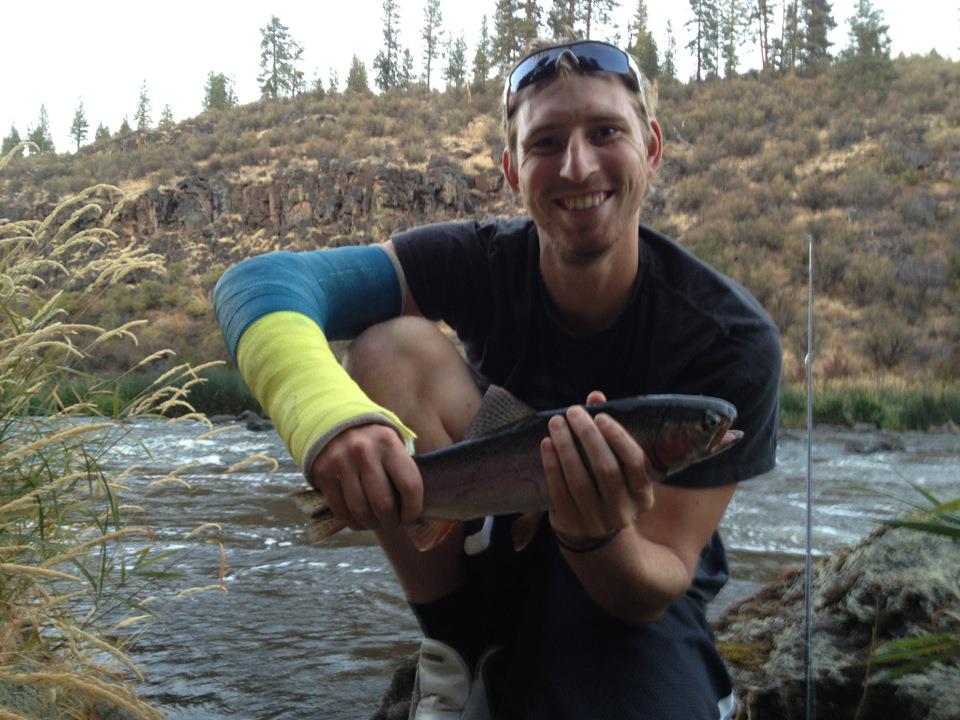Klamath River, OR
Trip Date: October 3, 2012

Alfred Lord Tennyson once said: “Tis better to have loved and lost, than never to have loved at all.”
Well, Tennyson was obviously a fisherman, because anyone who has fished enough understands just how painful fishing can be. It doesn’t stop at painful. In fact, at times, it can be downright cruel.
***
I’d long known fishing had a dark side, but it wasn’t until my second trip of the fall season to the Klamath River that I first experienced the painful, gut-wrenching misery that my lifelong passion could wreak.
After powering through classes and an ASOIT (Associated Students of Oregon Institute of Technology) meeting, one of my best friends, David Clarke, and I performed our weekly ritual. We quickly changed into old clothes, grabbed a few McChicken sandwiches and iced teas, then headed to the water.
I’d been unable to fully celebrate my favorite holiday — the October 1st Klamath River Fall Season Opener — two days earlier, and though I’d spent a few hours on the water before school that morning, I was desperate to get down there “for real.”
We caught a few of the healthy Redband Trout that make the Klamath Basin famous almost right away.
The fish of the Klamath are all deep-bodied, healthy fish which range in coloration from chrome-bright to more colorful fish, reminiscent of the Shasta Strain Rainbow Trout that many hatcheries raise for state stocking programs.
While the average size has since declined in the Klamath, during that year and the five years prior, fish averaged about 15 inches long and about 1.5 pounds.

That day, we were all about numbers, wanting to catch as many fish in the one-to-three-pound range as we could — not really hunting for trophies. Our lures of choice were Size 3 Blue Fox Vibrax Spinners.
So, when my lure stopped in the current, I assumed it’d snagged one of the countless rock altars submerged in the river, on which I’d sacrificed hundreds of dollars’ worth of gear over the years.
I assumed rock, until it moved.
The fish was big. Really big.
The river was only at about 800 cubic feet per second (CFS), which falls within the ideal range of approximately 400-1200 CFS, but this meant that the current wasn’t doing much of the pulling; it was mostly the fish.
We were wet-wading, as I usually do when fishing there, meaning we were fishing from a rock in the middle of the river, surrounded by water on all sides, and about 50 feet from the nearer shore.
The fish ran, jumped, and dove until I was finally able to bring it to net. Since David was on a rock a little distance away, I tried to net it myself.
I did everything right, too:
- The fight had lasted several minutes, and it was tired enough to handle, but not too tired to be released.
- I fought it to the sheltered water behind the large rock I was standing on, taking the current out of the equation.
- I led it headfirst into the net.
The only problem was that it didn’t fit.
It ran away into the current again.
I was dumbfounded. I’d never had this problem before.
I tried again, easing it into the net, but it got free again.
Horrified that it would throw the hook, I improvised the third time.
Propping the rod beneath my arm, I again led it into the net headfirst, but this time, I grabbed it around the tail, sort of bending it into the net. Both its head and tail stuck out of the net several inches, but I’d done it. It was landed.
For some reason, at this point my brain shut off.
Of the hundreds of fish I net from this river every year, I normally keep about five for the table. This one was by far the largest I’d ever caught, and that’s why it’s now hanging on my wall — or, at least, why it should be.
It does reside in my bedroom. Unfortunately, though, it’s haunting my dreams, not adorning my mantel, because what I did next, I still lose sleep over.
Rather than try to get to shore to weigh, measure, and photograph it, I tried to do that stuff right there. In the middle of the river. On a rock with a surface area the size of a doormat.
Somehow, it let me measure it with the retractable cloth tape measures I use that serve a purpose without hurting fish: 29 inches.
Wait. That can’t be right.
I measured again.
29 inches.
29 inches!
29 INCHES!!!
My longest Redband up to that point had been 22 3/4 inches, and I’d landed that fish almost eight years earlier.
Shocked and stupefied, thinking it was going to cooperate, I decided to weigh it. As I went to slide the scale under the gill plate, dream turned to nightmare.
The fish decided to break free.
The sheer power of this fish, this small salmon, in effect, was immense.
It’s body wriggled and pulsated as if all its demons were being exorcised in my hands.
The first thing I noticed were two of the three trebles finding purchase in the soft flesh of my thumb.
The third treble held tight in the fish, though, meaning every time it wiggled, the hooks drove deeper and deeper into my thumb.
Then the fish came out of the net, and the two hooks in my thumb held up the fish (which was, very conservatively, at least 8 pounds) for several excruciating seconds, before it threw the third hook and returned to the river, immediately darting to freedom, as I sat there, broken.

Both Klamath River ‘bands pictured here are about 20-21 inches long and 3.5-3.75 pounds, but were landed with different nets.Dejected, we fished a little longer, but no amount of fish 16-18 inches could ease the pain.
Poor David had to hear me whine and wallow for the next hour, as we approached one of my favorite spots: The River Monster Hole.
I call it this, because you half-expect Jeremy Wade to pull an enormous, toothy beast from its depths when you first see it. You stand on a shelf at the base of a 50-foot cliff that sits just above the punishing current below, a current that has dug the hole almost 20 feet deep in the channel.
Hoping the River Monster Hole would bring a chance at redemption, I changed from a spinner to my go-to CD-9 Rapala in hopes of enticing a larger fish with the larger lure. I dropped the rod to the ground, propping it between my knees as I held the line near the lure and clipped the line further towards the rod tip.
My mistake hit me with the same slow, Earth-shattering realization I’d had just an hour before while trying to weigh my largest freshwater fish ever.
Since I was holding the segment of line I’d just clipped, I watched in helpless slow motion, groping just out of reach, as my rod leaned away from me and plopped into the rushing river below.
I’m sure my slow blinks had cartoony sound effects, as I stood there, speechless.
I was devastated. It wasn’t the same caliber rod and reel I use today, but it was still a quality setup. It was the two pieces of equipment I’d recommend to anyone starting to get into fishing who wants a good setup but doesn’t want to break the bank: an Ugly Stik Elite 7-foot Medium-Fast Rod and a Pfleuger President Spinning Reel
. Together, they’ll run you about $100 and work great for the average weekender for years.
But for me, they were an extension of who I was.
David did his best to console me, but he’d fallen in earlier and was soaked head-to-toe. Well, not quite. He was in a cast and had managed to keep his arm above water and dry, despite being soaked everywhere else. The October air had begun to turn crisp, and we looked at each other with one unspoken thought in common: leave.
The walk up to the car and the drive home were both largely silent affairs as we commiserated together.
***
It took me four days of bitterness and depression to finally climb back onto the horse. I purchased a new rod, tied on a lure (very carefully this time), and returned to the same river that had rewarded and punished me so extremely earlier that week.
***
It took me almost five years, but I did catch a trout bigger than that. Then another. Then several more. I’ve now landed a lot of massive trout, but even bigger fish remain.
I know that fish and its peers still swim those waters, because in Winter of 2011, my friend Ben Fry landed this one.

He didn’t have a scale on him at the time, but it measured 32 inches long — even larger than the fish I’d landed. And, after a good photo, he released it back into the river, a gesture Tennyson would have applauded.
#CaughtOvgard
Read Hook #7: Danger.



I don’t think the title of your article matches the content lol. Just kidding, mainly because I had some doubts after reading the article.